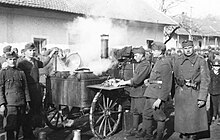Field kitchen
Karl Rudolf Fissler of Idar-Oberstein invented a mobile field kitchen in 1892 that the Germans came to refer to as a Gulaschkanone ("goulash cannon"), because the chimney of the stove resembled ordnance pieces[1] when disassembled and limbered for towing.
As technology advanced, larger trailers evolved as horses were phased out in favor of motorized vehicles more capable of towing heavier loads.
In World War II, the mobile canteen was used as a morale booster in the United Kingdom, fitting in with the culture of the tea break and in particular as a result of the successful wartime experiment of the tea lady on productivity and morale.
Though they are not necessarily mobile kitchens, they are designed to be unpacked, assembled, and repacked with relative haste.
[5][6] Some modern militaries use mobile facilities that are not field kitchens, but supplement them or are components of them, such as large tents for dining halls.
Field kitchens are deployed by militaries or aid agencies to feed groups of refugees, displaced persons, or first responders as part of humanitarian aid, disaster response, and emergency management operations.



